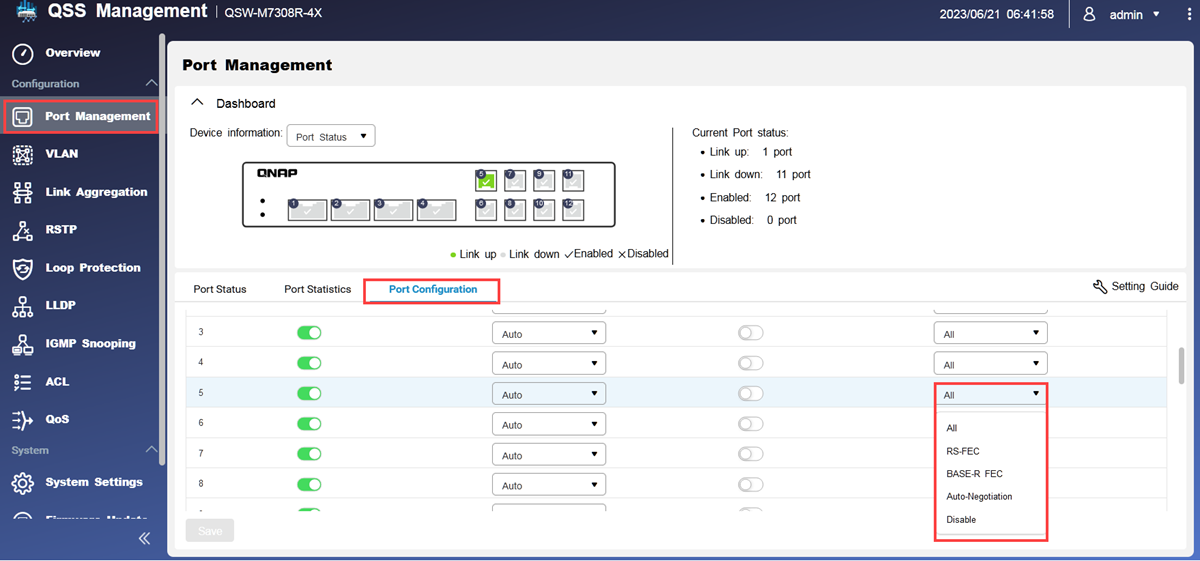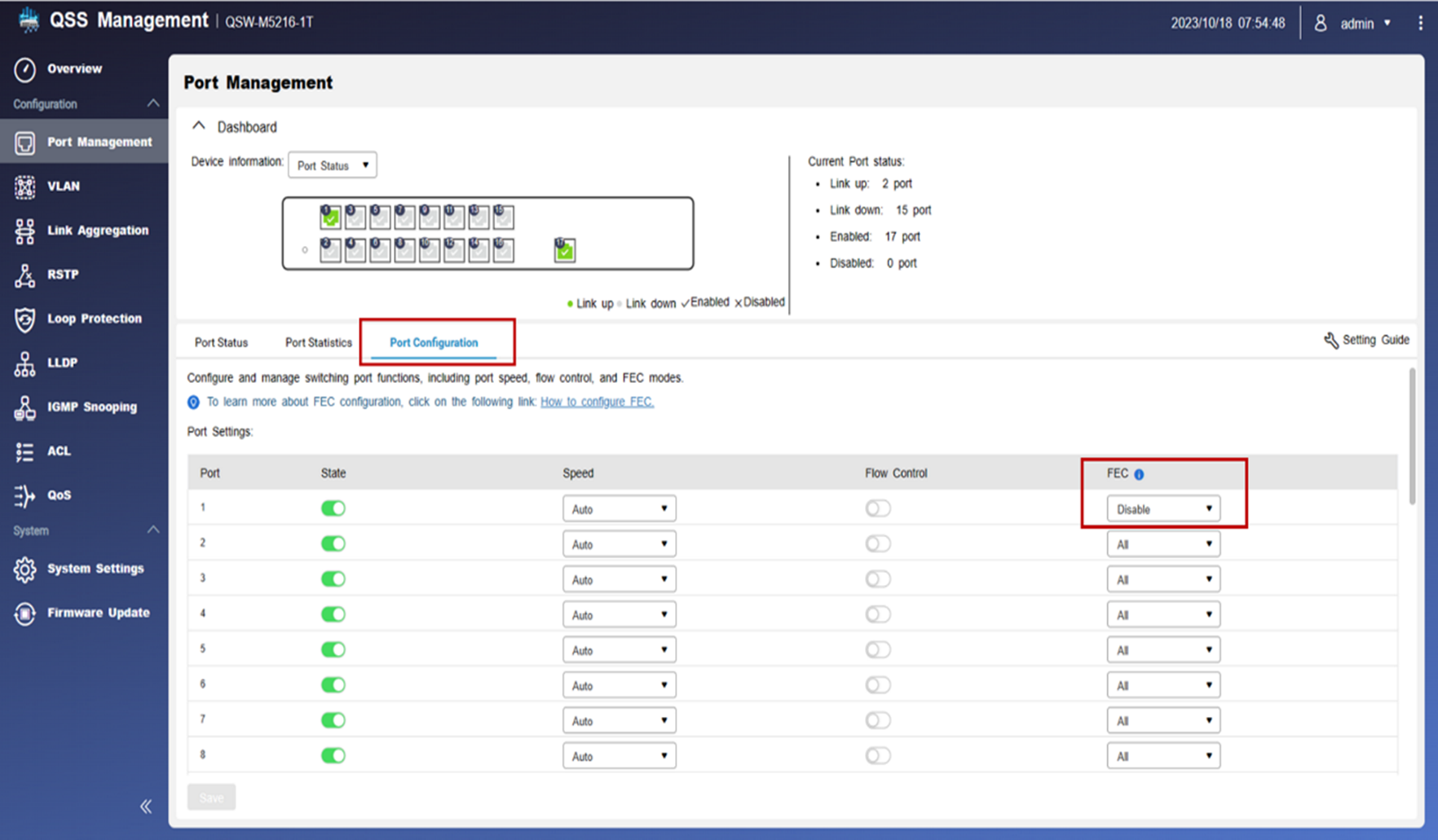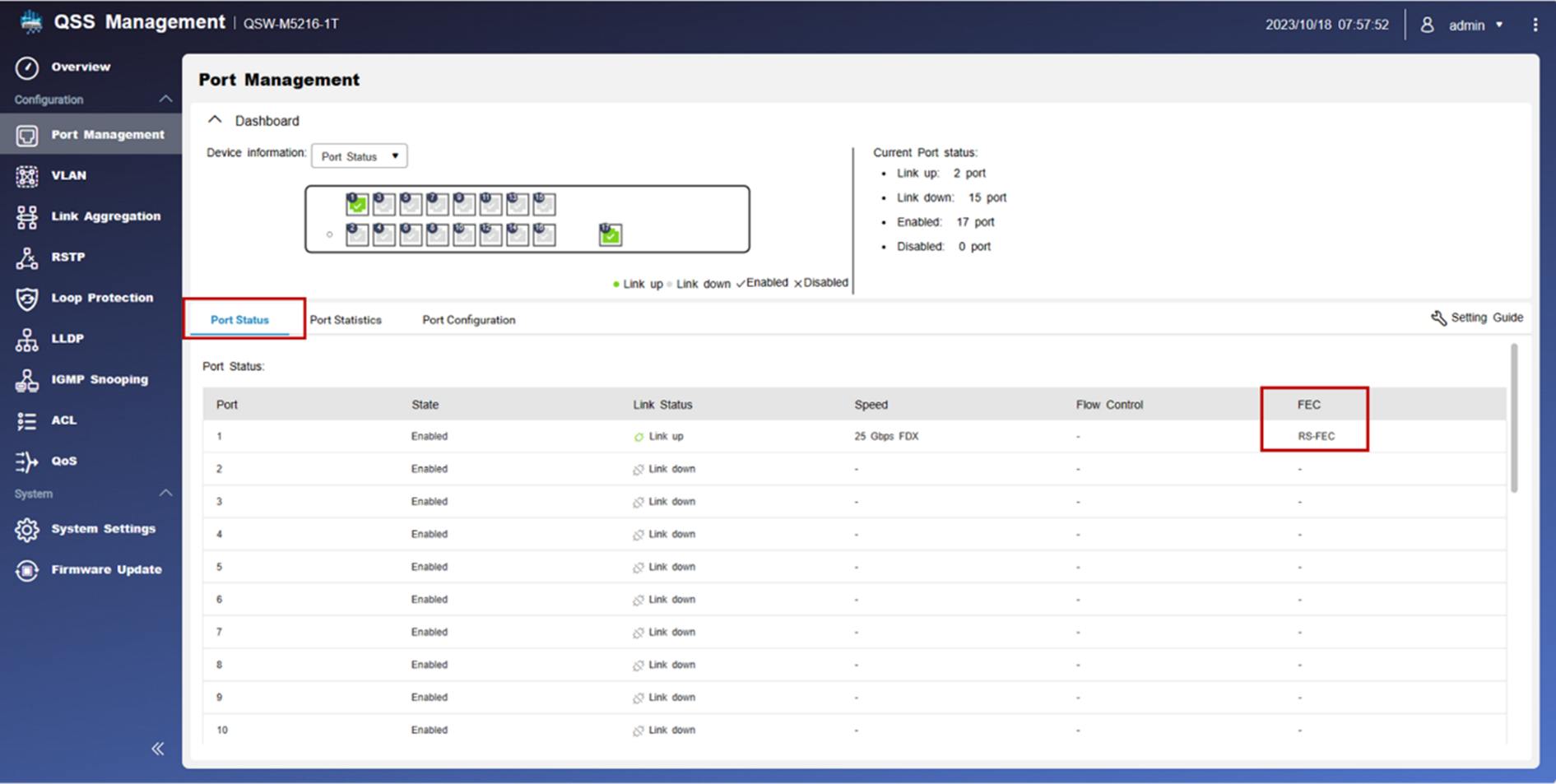Configuring and Troubleshooting FEC Settings on QNAP QSW Managed Switches
Applicable Products
Hardware
- QSW-M7308R-4X
- QSW-M5216-1T
Software
- QSS v1.4.2 and later
- QSS Pro v4.0.0 and later
Overview
Forward Error Correction (FEC) is a method of data communication where extra bit(s) known as error correction bits are encoded with the data to help detect and correct errors even during high-speed transmissions (100G/25G) and long-distance network transmission. The receiver uses these extra bits to check the received data against the transmitted data. If an error is detected, the receiver can then use added FEC bits to correct the error and get the correct value of the original data.
Procedure
- Log in to QSS.
- Go to Port Management > Port Configuration.
- Under Interface Settings, identify a switching port.
- Under FEC, select a mode from the drop-down list.

FEC Mode Description All The switch automatically selects the best FEC mode (excluding the Auto-Negotiation FEC mode) to transmit and receive data packets. RS-FEC Reed -Solomon (RS) FEC provides enhanced data correction rates on the transmitting and receiving devices. BASE-R-FEC Fire-Code FEC or BASE-R-FEC offers weaker correction rates but offers lower latency compared to RS-FEC on 25 GbE switching ports. Auto-Negotiation Uses the clause 73 auto-negotiation function for use over electrical backplanes on a switching port. An FEC automatic negotiation (AN) request message is transmitted to determine a negotiated FEC process between the switching ports. Disable Disables FEC on all the switching ports. Note- Use Auto-Negotiation to automatically determine the link capabilities and eliminate manual configuration of FEC. Auto-negotiated FEC is best used when the data rate needs to be adjusted to the network situation.
- Use RS-FEC when the data requires additional protection from noise and other data loss sources.
- BASE-R-FEC is used for networks operating at high speeds. This is the highest speed FEC available and is most suitable for mission-critical networks and applications.
- For specific network cards, manual matching of Forward Error Correction (FEC) settings is required between the switch and the card. For a detailed listing of compatible network cards, see QNAP Compatibility List.
TipTo view the current FEC mode applied to the interfaces, go to Port Management > Port Status. - Click Save.
QSS saves the FEC mode on the selected switching ports.
Troubleshooting Common FEC Issues
Scenario 1: Troubleshooting Common FEC Compatibility Issues
In situations where link-up connections exceeds 30 seconds or network communication between the card and switch is not established, investigating potential mismatched FEC modes is recommended. Prolonged link-up times or complete link-up failures can be attributed to mismatched FEC modes configured on the transmitting and receiving network devices. This section documents confirmed workarounds for situations where FEC mode mismatches occur between network cards and QNAP switches operating at 100Gbps or 25Gbps port speeds.
FEC mode: All
NIC OS platforms: Windows, Linux
Workaround 1: Select the same FEC mode on both devices
Workaround Steps- Disconnect the Ethernet cable connecting the two devices.
- Select the same FEC mode (e.g., RS-FEC, BASE-R-FEC) or disable FEC on both devices.
- Save the FEC configuration.
- Securely plug the Ethernet cable to an available port on the switch and then connect the other end of the Ethernet cable to the network card port.
Workaround 2: Change the FEC mode to Auto-Negotiation
Workaround Steps
- Disconnect the Ethernet cable connecting the two devices.
- On the QNAP switch, change the FEC mode to Auto-Negotiation.
- Save the FEC configuration on the switch.
- Securely plug the Ethernet cable to an available port on the switch and then connect the other end of the Ethernet cable to the network card port.
FEC mode: RS-FEC, BASE-R-FEC, Disable
NIC OS platforms: Linux
Workaround 1: Configure the same FEC mode on both devices
Workaround Steps
- Disconnect the Ethernet cable connecting the two devices.
- Select an FEC mode (RS-FEC, BASE-R-FEC) or disable FEC on the switch.
- Save the FEC configuration on the switch.
- On the network card, select the same FEC mode.
$ethtool --set-fec swp1 encoding [off | BaseR | auto] - Save the FEC configuration on the network card.
- Securely plug the Ethernet cable to an available port on the switch and then connect the other end of the Ethernet cable to the network card port.
An illustrative case would be a network card unable to achieve link-up with the switch when configured for the preferred FEC mode, such as RS-FEC.
- Disconnect the Ethernet cable connecting the two devices.
- On the switch, change the FEC mode to BASE-R-FEC.
- Save the FEC configuration on the switch.
- On the network card, select BASE-R-FEC.
- Save the FEC configuration on the network card.
- Securely plug the Ethernet cable to an available port on the switch and then connect the other end of the Ethernet cable to the network card port.
QSS changes the FEC mode to BASE-R-FEC.
Workaround 2: Reconfigure the FEC mode on the network card
Workaround Steps
- Disconnect the Ethernet cable connecting the two devices.
- Disable FEC on the network card.
$ethtool --set-fec swp1 encoding [off] - Save the FEC configuration.
- Change the FEC mode to the preferred FEC mode on the network card (RS-FEC).
- Save the FEC configuration.
- On the switch, change the FEC mode to RS-FEC.
- Save the FEC configuration.
- Securely plug the Ethernet cable to an available port on the switch and then connect the other end of the Ethernet cable to the network card port.
QSS displays the FEC mode as RS-FEC.
FEC mode: Auto-Negotiation
NIC OS platforms: Windows, Linux
Workaround 1: Select the same FEC mode on both devices
Workaround Steps
- Disconnect the Ethernet cable connecting the two devices.
- Select the same FEC mode (e.g., RD-FEC, BASE-R-FEC) or disable FEC on both devices.
- Save the FEC configuration.
- Securely plug the Ethernet cable to an available port on the switch and then connect the other end of the Ethernet cable to the network card port.
Workaround 2: Change the FEC mode to All
Workaround Steps
Selecting Auto-Negotiation may result in connection issues on the switch if the connected network card does not comply with the IEEE802.3ap standard.
- Disconnect the Ethernet cable connecting the two devices.
- Change the FEC mode to All on the switch.
- Save the FEC configuration.
- Securely plug the Ethernet cable to an available port on the switch and then connect the other end of the Ethernet cable to the network card port.
Scenario 2: Troubleshooting Discrepancies in QSW-M5216-1T FEC Mode Display
An intermittent discrepancy may occur between the configured FEC mode and the displayed FEC mode on the QSW-M5216-1T switch while in link-up state.
In the following example, changing the FEC mode on a QSW-M5216-1T switch from RS-FEC to Disable resulted in a discrepancy between the configured and displayed modes in QSS. While the actual FEC mode was disabled, QSS continued to show RS-FEC.

Workaround
- Disconnect the Ethernet cable connecting the two devices.
- Securely plug the Ethernet cable to an available port on the switch and then connect the other end of the Ethernet cable to the network card port.
- Log in to QSS.
- Go to Configuration > Port Management > Port Status.
QSS displays the configured FEC mode.


